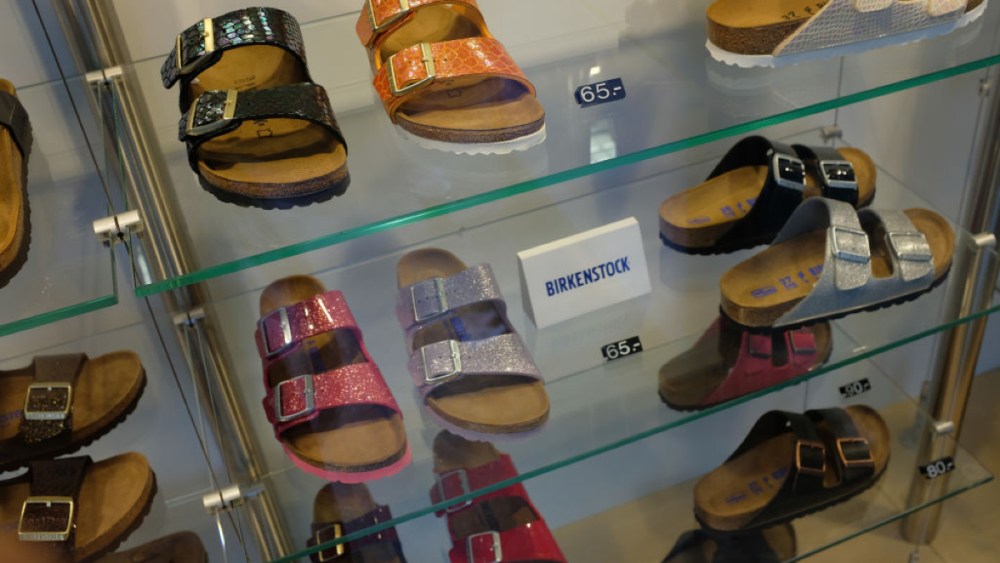
Birkenstock Holding plc has much to be happy about in its third quarter earnings report.
Key highlights from executives during its third quarter earnings conference call include how a shift to in-person shopping will benefit Birkenstock’s wholesale business over DTC retail operations, what levers are available to manage the 15 percent U.S.-EU tariffs, and why select price increases so far hasn’t slowed consumer demand.
“We continue to see the shift to in-person shopping, which amplifies our brand. We are a touch-and-feel product, especially for consumers who are new to the brand,” Birkenstock CEO Oliver Reichert told investors on the call. “We have over 12,000 high-quality touch points through our B2B partners compared to our own fleet of 90 doors. That is why this shift in consumer behavior favors our B2B channel over DTC.”
He said the brand is winning at retail as it gains shelf space and takes market share. “In a flat U.S. market, retail revenue at our top 10 wholesale partners was up 25 percent. As you do your channel checks for back-to-school, you will hear that Birkenstock is the winner with very strong sellout and fast inventory turns,” the CEO said.
Reichert said the same is true for the EMEA (Europe, Middle East and Africa) region. “Retail revenue at our top 10 partners was up 20 percent. Within our B2B channel, over 90 percent of the growth came from within existing doors. We are committed to maintaining relative scarcity and managing tightly our distribution growth,” he explained.
The company is on track to reach its goal of 100 stores by the end of the current fiscal year. Birkenstock has accelerated the pace of store openings, adding 13 new doors thus far. The expectation is a return of CapEx within 12 to 18 months of an opening, helped by higher average selling prices and higher units per transaction from the first day of a store’s opening. Reichert said the store openings allow the brand to capture more in-person shopping demand within its own DTC business since the stores can showcase the brand’s full product assortment.
“Our brand heat is stronger than before,” Reichert said, noting full-price sell-throughs and Birkenstock’s strong order book. He also cite the emerging youth market as a runway for growth. “Our demand is strong across all product categories and target groups. Sales of our [classic] silhouettes grew double digits. Demand for our iconic styles, such as the Arizona and Boston remains strong and is accelerating within the younger demographic,” the CEO said, adding that at the same time, “we are growing in expansion categories such as laced-up shoes.” He noted that closed-toe share of revenue increased by 400 basis points year-over-year.
CFO Ivica Krolo said that B2B growth outpaced D2C in the quarter, with B2B revenue up 18 percent and DTC up 12 percent, both on a constant-currency basis. D2C share of the business was 38 percent, down 110 basis points versus the same year-ago quarter.
“B2B has proven to be the most cost-efficient way to target new consumer groups,” he said. “We now expect B2B growth to outpace D2C in both the fourth quarter and for the full year.” As a demand-driven brand, Krolo said the company is strategically allocating product to where the consumer is shopping. “And unlike our peers, we own our supply chain. The B2B order book provides predictability and de-risks our planning,” the CFO noted.
Krolo also said that the company can manage the impact of the baseline 15 percent EU tariff through actions already taken, including targeted price increases. He said in the first quarter that Birkenstock would only need a low-single-digit price increase globally for a full offset of the tariff impact. On Thursday’s call, the CFO elaborated on other tools at Birkenstock’s disposal: “Pricing is not the only lever we have. Given our vertical integration, additional levers include efficiencies in production, vendor negotiations, the optimization of the product mix and the allocation of products between the regions.”
The CFO also disclosed that the brand entered 2025 with an effective tariff rate of 11 percent, which at one point went up to 21 percent in April when including the 10 percent reciprocal rate. While noting that the manageability of the new baseline, he also said, “We have some items that are already tariffed at over 15 percent and those higher tariffs, historical tariffs, will remain in place.”
As for price increases in the U.S. due to anticipated higher costs connected to tariff increases, David Kahan, president of Americas, said price adjustments for select styles became effective on July 1 and that the brand has “seen no impact whatsoever since we took our pricing increases.”
With six weeks past the price actions under its belt, recent channel checks indicate “velocity and sell-through” for the brand from July and into the second week of August, Kahan explained. He said that period includes a significant portion of the U.S. back-to-school season, adding that sales have been “exceptional and it’s escalated even beyond the selling results we had in Q3, which historically was when we would have high spring peak sell-throughs.”
Kahan also that 90 percent of growth is from existing doors due to more styles, stock-keeping units and some added depth in inventory.
And EMEA president Mehdi Nico Bouyakhf reiterated growth for the brand in the region, noting that same-store sales in retail rose double-digits and price increases for Spring-Summer 2025 didn’t see any consumer pushback, resulting in full price sales at over 90 percent. Contributing to full-price sales was a structural demand issue in the quarter where consumer appetite for the brand was greater than product availability, Bouyakhf said.
Members of the management team have said that the brand overall tends to limit production capacity to maintain a level of scarcity in the market.
For the three months ended June 30, net income jumped 73.1 percent to 129.2 million euros, or 0.69 euros a diluted share, from 74.6 million euros, or 0.40 euros, a year ago. Revenue for the period rose 12.4 percent to 635.0 million euros from 564.8 million euros a year ago.
For the six months, net income rose 82.9 percent to 254.5 million euros, or 1.36 euros a diluted share, from 139.1 million euros, or 0.74 euros, in the same year-ago period. Revenue rose 16.5 percent to 1.57 billion euros from 1.35 billion euros.
The company on Thursday reiterated it prior guidance for fiscal 2025, with revenue growth expected at the high end of a 15 percent to 17 percent range on a constant currency basis.
Meanwhile, Birkenstock 1774 has been busy reimagining the classics to give consumers a reason to buy the brand’s footwear. April saw the launch of a nylon version of the Arizona sandal — Karl Birkenstock debuted the original silhouette in 1973 — in several monochrome colors. That was followed in May with Birkenstock 1774 and Maharishi teaming up to launch its outdoor Mogami Terra Tech sandal.
#Birkenstock #Holding #BIRK #Earnings #Revenues #Consumer #Demand






